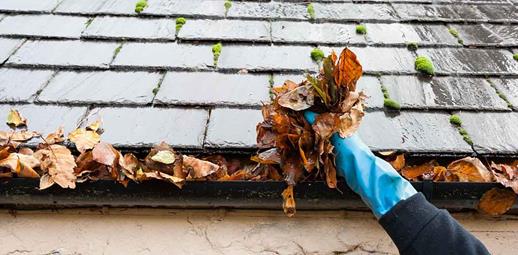
Follow our step-by-step guide to safely and effectively clean your gutters. Keep your gutters flowing freely and prevent damage to your roof.
EASY AS HACK
Follow our step-by-step guide to safely and effectively clean your gutters. Keep your gutters flowing freely and prevent damage to your roof.
AT A GLANCE
|
1. Clean your gutters at least twice a year 2. Replace broken sections of guttering as they get worn 3. Check and clean the downspouts |
What equipment do you need to clean your gutters?
- Ladder - Your safety is the most important thing, so make sure your ladder is sturdy and can support your weight. It needs to be tall enough to reach the height of your gutters.
- Bucket - Before you pull any leaves and debris out of your gutters, you’ll need a container to collect the refuse. A large bucket should do the trick or even a sturdy rubbish bag.
- Hose - A garden hose should be sufficient to clean your gutters, but you may use a high-pressure hose if preferred.
- Gloves - Protect your hands from debris and sharp edges of tiles and slates with a good pair of gardening gloves.
- S hook - For easy access to your bucket, secure it to your ladder with an S hook.
- Sink wire - A sink wire will come in handy when checking the downpipe for blockages.
How to clean gutters and downpipes
- Set up your ladder - Place your ladder at a stable angle, about 75 degrees from the base of the wall. If your ladder comes with safety instructions, be sure to follow them.
- Climb the ladder with your bucket and hose - Once your ladder is secure, grab your bucket, S hook and hose, and climb the steps to the appropriate height so you can reach your gutters.
- Secure your bucket to the ladder - Use the S hook to hang your bucket on the ladder so your hands are freed up to start removing debris.
- Clear loose debris by hand - Pull out any larger debris from your gutters first, taking care to not leave a mess on nearby windows and walls.
- Use a sink wire to clear the downpipes - A downspout, or downpipe, is a vertical pipe that carries rainwater from the gutters. If these are blocked, use a sink wire to flush out any debris caught inside.
- Clear out any sludge or debris with a hose - With the larger debris already cleared, use the hose pipe to rinse away any remaining dirt in the gutters and downpipes.
- Inspect for signs of damage - Once your freshly cleaned gutters and downpipes have dried completely, check for rust, leaks and holes. You’re most likely to see these at the joints, where metal edges were welded together. Rust spots and holes can be mended with scrap wire screening and asphalt roof cement, which you can buy in DIY stores.
How to clean gutters from the ground
When attempting to clean your gutters from the ground, it’s always better, more efficient and safer to hire a professional gutter cleaning service. Professional gutter cleaning companies have the proper equipment and training to access hard-to-reach gutter systems safely and effectively.
However, there is equipment that can help with cleaning gutters from the ground.
- Power washer - One of the safest ways to clean gutters from the ground is to use a power washer or pressure hose. Attach a gutter cleaning nozzle and extender to dislodge and wash away leaves and debris seamlessly.
- Garden hose - Although using a garden hose may not be the ideal way to clean your gutters from the ground, it can be done. For more effective cleaning, you can buy a gutter cleaning attachment with a curved shape to help direct the flow of water more directly into the gutters.
- Leaf blower - You can buy an attachment for your leaf blower to get into your gutters – the attachment is a long pipe with a curved end to fit inside the gutter and blow out debris from inside the gutter.
How to tell if your gutters need cleaning
- Water is overflowing - Water cascading over the top of your gutters is a pretty clear sign that they need cleaning. If this is happening, it means there’s something blocking the water flow and preventing it from flowing down the drain pipes.
- Your gutters are sagging - A sagging gutter is a sign of heavy debris or logged water inside. When the load is too heavy for the gutter’s structure to support it, the weighed-down area may become bent and damaged over time. The repairs can be costly, so it's best not let your gutters get to this point.
- Stains are appearing on your fascia or soffits - Marks and discolouration on your fascia or soffits could indicate water damage, most likely caused by a problem with your gutters. Stains tend to appear when stagnant water trapped in the gutter becomes dirty and sits for too long.
- You can see weeds growing in your gutters - Strong winds, birds and insects carry seeds and plant matter into the air, which can settle in your gutters. The abundance of sunlight and water means they become a perfect growing ground for weeds and other pesky plants. So, if you see any starting to sprout, you can bet it’s time for a good gutter cleaning.
- You have a leak or internal walls are wet - Leaks and damp marks on internal walls may indicate a blocked gutter. If rainwater from the gutter has nowhere to go, it could end up pooling in your roof or seeping through the walls of your home – neither of which is ideal to repair. To help prevent costly water damage in your home, it’s best to keep your gutters clear at all times so water can escape to the drains.
- Damage to exterior paint - Not only can trapped gutter water leave damp marks on your walls, but it can also damage the paintwork. When paint is peeling, bubbling or chipping in areas, this could be a sign that your gutters are blocked – another costly repair that can be avoided with regular checks.
How often should you clean your gutters?
Ideally, you should clean your gutters twice a year. If you’re able to reach them safely, you can clean your gutters yourself. Aim to do this in late spring and late autumn, as a minimum. If you live in a wooded area and your gutters easily fill up with leaves and other debris, then you’ll need to give them a clean more often.
How to maintain your gutters
- Clean your gutters regularly - It’s recommended that you clean your gutters once in autumn and once in spring. Autumn is the leaf fall season, so naturally, you would want to clear out the excess that collects in your gutters over this time. Spring brings heavier showers that can wash silt into your gutters and allow seedlings to take root – also problematic for blockages.
- Use gutter guards - Taking a proactive approach to gutter cleaning can save you time and money in the long run. Gutter guards are designed to stop leaves, twigs and moss from entering your gutters. You can invest in these to prevent a build-up of debris from happening in the first place, keeping your gutters clearer for longer.
- Hire a professional - We don’t all have the time, skills or equipment to clean our gutters ourselves. And sometimes, leaving it to the professionals is the better option anyway as they know exactly what to do to get the job done properly, and more importantly, safely. If you want to take this route, you can put a plan in place for your trusted expert to take care of your gutters twice a year.
What happens if you don’t clean your gutters?
Over time, gutters can develop issues that stop them from functioning the way they should. This can lead to a number of issues, including:
- Overflowing and leaking - The water that collects in your gutters has to go somewhere. And if it can’t go down the pipes to the drain due to a blockage, it can end up pouring over the edge of the gutters or through holes and cracks.
Damage to your gutters - When there’s a blockage, the excess weight of the water and debris gathering inside can cause gutters to sag and deteriorate over time, eventually requiring costly replacements. - Build-up of mould - When leaves sit for long periods of time in wet gutters, they begin to decompose and eventually rot. This creates a breeding ground for mould, which can cause health problems if it enters your home.
- Roof damage - The longer your gutters are neglected, the more likely it is that your entire roof may need replacing. Once gutters are clogged, rainwater can soak through the shingles, rot fascia and soffits, and eventually seep into your home, causing significant damage to the roof itself as well as the ceilings and interior walls. If the damage gets to this point, your bank balance better watch out.
- Property damage - Not only are leaks from bursting gutters harmful to your home interior, but they can also destroy your property at the foundational level. Excess water that can’t drain properly can pool on the driveway, causing cracks to form and mould to spread. A decaying foundation means an irregular surface, which can even cause your home to start leaning over if left unattended over a significant period of time.
- Bugs and pests - Another problem that can arise due to blocked gutters is the infestation of pests. Stagnant water in gutters is a breeding ground for moulds and fungi, not to mention mosquitoes and other unwanted insects.
Whether you do it yourself, or seek help, regularly giving some attention to your gutters is an essential part of home maintenance and can help you keep your home safe, even on rainy days.
FAQ’s
Can you clean gutters in the rain?
Yes, you can, but only if you’re not using a ladder as the slippery conditions can be dangerous. If you are cleaning your gutters from the ground, the rain can actually help to dislodge debris.
How do you remove gutter guards for cleaning?
Inspect to see how the gutter guards are attached. They will either be clicked in place or positioned with screws. Removal will differ depending on how the gutter guard is fixed.
Find out more about our home insurance.


